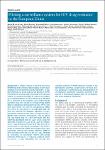Piloting a surveillance system for HIV drug resistance in the European Union
van de Laar, Marita J. W.
Bosman, Arnold
Pharris, Anastasia
Andersson, Emmi
Assoumou, Lambert
Ay, Eva
Bannert, Norbert
Bartmeyer, Barbara
Brady, Melissa
Chaix, Marie-Laure
Descamps, Diane
Dauwe, Kenny
Fonager, Jannik
Hauser, Andrea
Lunar, Maja
Mezei, Martha
Poljak, Mario
van Sighem, Ard
Verhofstede, Chris
Amato-Gauci, Andrew
Broberg, Eeva K.
Background
A steady increase in HIV drug resistance (HIVDR) has been demonstrated globally in individuals initiating first-line antiretroviral therapy (ART). To support effective use of ART and prevent spread of HIVDR, monitoring is essential.
Aim
We piloted a surveillance system for transmitted HIVDR to assess the feasibility of implementation at the European level.
Method
All 31 countries in the European Union and European Economic Area were invited to retrospectively submit data on individuals newly diagnosed with HIV in 2015 who were tested for antiviral susceptibility before ART, either as case-based or as aggregate data. We used the Stanford HIV database algorithm to translate genetic sequences into levels of drug resistance.
Results
Nine countries participated, with six reporting case-based data on 1,680 individuals and four reporting aggregated data on 1,402 cases. Sequence data were available for 1,417 cases: 14.5% of individuals (n = 244) showed resistance to at least one antiretroviral drug. In case-based surveillance, the highest levels of transmitted HIVDR were observed for non-nucleoside reverse-transcriptase inhibitors (NNRTIs) with resistance detected in 8.6% (n = 145), followed by resistance to nucleoside reverse-transcriptase inhibitors (NRTI) (5.1%; n = 85) and protease inhibitors (2.0%; n = 34).
Conclusion
We conclude that standard reporting of HIVDR data was feasible in the participating countries. Legal barriers for data sharing, consensus on definitions and standardisation of interpretation algorithms should be clarified in the process of enhancing European-wide HIV surveillance with drug resistance information.
Dateien zu dieser Publikation

